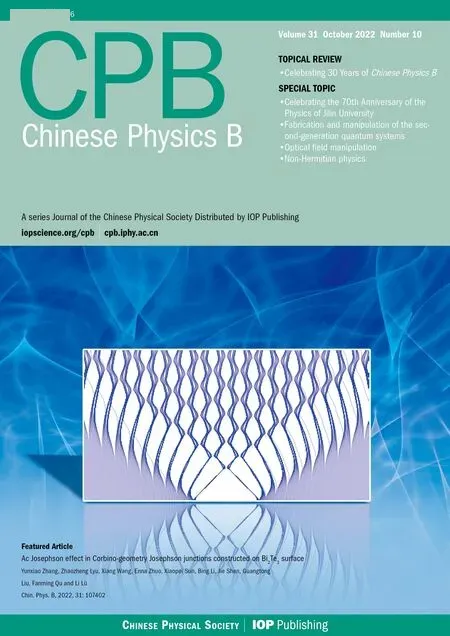Phase-matched second-harmonic generation in hybrid polymer-LN waveguides
Zijie Wang(王梓杰) Bodong Liu(刘伯东) Chunhua Wang(王春华) and Huakang Yu(虞华康)
1School of Physics and Optoelectronics,South China University of Technology,Guangzhou 510641,China
2School of Electrical Engineering and Intelligentization,Dongguan University of Technology,Dongguan 523808,China
3China–Singapore International Joint Research Institute,Guangzhou Knowledge City,Guangzhou 510663,China
Keywords: nonlinear waveguides,super-mode theory,phase matching,second harmonic generation
1. Introduction
Nonlinear optical conversion is crucial for modern photonics.[1,2]Along with advance in high-profile fabrication techniques,various platforms of integrated photonics are rapidly developed in the past decades, giving rise to diverse on-chip applications, including data communication, optical sensors, and optical interconnection.[3–6]Generally, on-chip devices could tightly confine the light field within a small volume, leading to dramatically enhanced light–matter interactions with superior performance.[7]In particular,efficient nonlinear frequency conversions can be achieved in photonic integration platforms composed of materials with strong secondorder nonlinearity,such as LN and AlN.[8–11]
It is known that the realization of phase-matching condition is vital for nonlinear optical conversions, such as second-harmonic generation.[1,2]For nonlinear optical processes inside photonic waveguides, several strategies for realizing phase-matching condition have been proposed and demonstrated, including quasi-phase matching (QPM),[12–14]birefringence phase matching (BPM),[15]and modal phase matching (MPM).[16]QPM is realized by domain patterning of the nonlinear susceptibility of waveguide, but limited by the domain size for further integration into photonic circuits. Meanwhile, BPM is only available for phase matching at specific wavelength.[15]For the traditional MPM method,phase-matching condition is usually achieved between zeroorder mode of fundamental wavelength and high-order mode of second harmonics, the distinct spatial distributions between which would correspond to poor overlap and prevent high conversion efficiency. Various nanostructures have been demonstrated to improve the spatial overlap integral, such as ring resonators, high-quality photonic cavities, and optical waveguides.[17–28]Notably, high-quality thin-film lithium niobate on insulator (LNOI) is now commercially available,which would significantly extend associated applications in on-chip nonlinear optics.[11]To be noted, a novel special waveguide structure, namely reversed-polarization doublelayer LN waveguide, was proposed with large modal overlap integral and high efficient nonlinear frequency conversion.[29]
Based on LNOI, hybrid nanophotonic waveguide has been proposed by introducing a fabrication-friendly material (such as polymer, TiO2, silicon) on the top of LN substrate.[30–34]And new phase-matching condition can be achieved between a fundamental mode at the fundamental wavelength and a high-order mode at the second harmonics. It is noted that such hybrid waveguiding structure can be treated as an asymmetric coupled waveguide,composed of the top polymer waveguide (χ(2)=0) and the bottom thinfilm LN waveguide (χ(2)/=0). Inside such coupled waveguides,guided waves would split into even and odd modes for the fundamental waveguiding mode, and the superposition of these supermodes would lead to energy exchanging between the two waveguides.[35–37]Notably, the rise of supermodes enables new schemes for the phase-matched nonlinear optical process, since extra momentum can be obtained during the coupling processes both for the fundamental and secondharmonic waves.According to super-mode theory,this mechanism of phase matching has been implemented inside symmetric coupled nonlinear optical waveguides with identical material,while enabling large spatial modal overlap factors.[38–40]However, restricted by the fabrication technique of LN material, it is difficult to construct coupled waveguides with the same LN materials. Therefore, it is natural to bring in mind that one could construct a composite waveguide structure by patterning a fabrication-friendly material, such as polymer or silicon,on top of high-quality LN thin film.[33,34]Such waveguide structure could be readily fabricated and promising for excellent optical performance. Considering the low optical loss of polymer in the visible range, we prefer to construct polymer-LN semi-nonlinear waveguide in this paper.
According to super-mode theory, we investigate phasematched second-harmonic generation inside a hybrid polymer-LN semi-nonlinear waveguide, composed of the top polymer waveguide and the bottom thin-film LN waveguide. Geometric parameters of the hybrid waveguide were carefully engineered and optimized parameters were obtained numerically.Phase-matching conditions were closely investigated with corresponding modal overlap integrals calculated.
First, we look back at the phase-matching condition of SHG in a symmetric coupled waveguide structure. Here, we take SHG,i.e.,ω2= 2ω1, as an illustration. According to super-mode theory,[35–37]fundamental waveguiding mode of each single waveguide would split into a pair of modes,i.e.,even (symmetric) or odd (antisymmetric) modes, as a result of perturbation-induced coupling interaction between the two waveguides. The combination of even and odd modes in the coupled waveguide structure would lead to power exchange between the two waveguides. Additional possibilities in realizing phase matching become available by employing the emerging even and odd fundamental modes in nonlinear optical interactions processes. We have listed all the six possible phase-matching conditions as given in Table 1.[38]
2. Theory
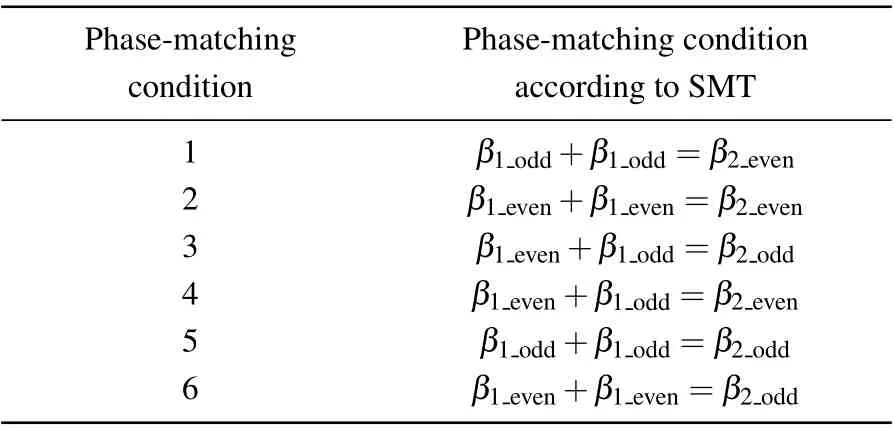
Table 1. Phase-matching condition of SHG in coupled waveguides(from Ref.[38]).
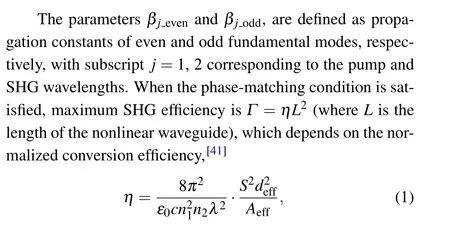
whereε0andcare the permittivity and light speed in vacuum;n1andn2represent the effective modal refractive indices of the pump and SHG;λis the pump wavelength;deffis the effective nonlinear susceptibility;Srepresents effective modal overlap integral between the pump and SHG modes over the effective nonlinear optical region,[23,42]
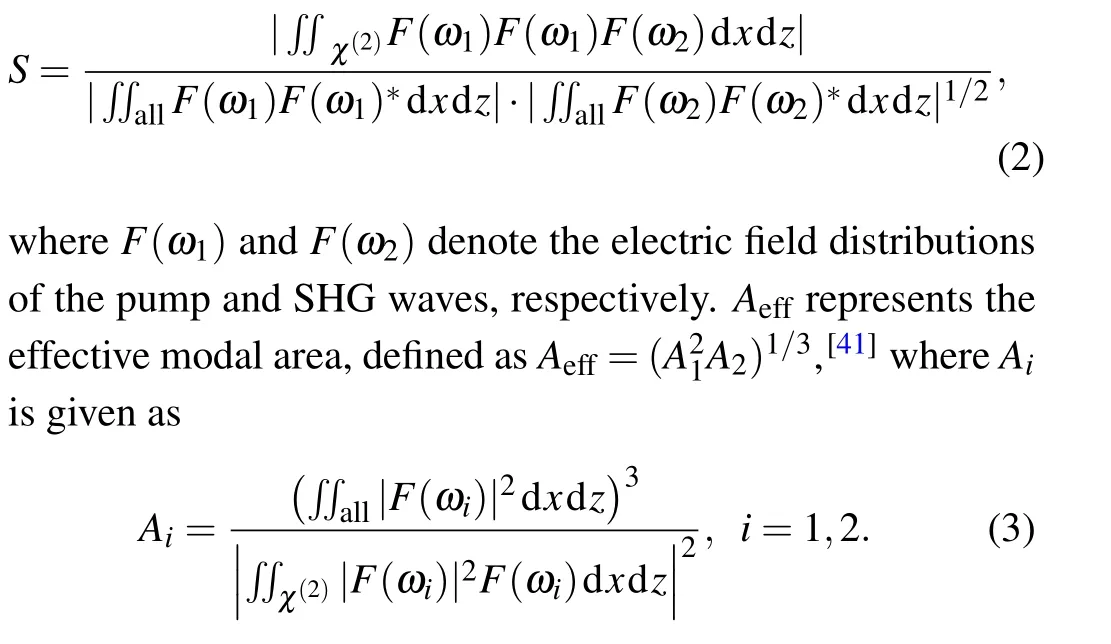
The overlap integralSbecomes considerably large due to the identical spatial distributions between the fundamental pump modes and SHG fundamental modes inside the nonlinear optical waveguide. However,it is noted that phase-matching conditions 4–6(as listed in Table 1)are not applicable in the symmetric coupled waveguides, which can be easily deduced as one checks the mathematical symmetry properties of modal overlap integrals[see Eq.(2)].
For asymmetric coupled waveguides, the prohibition of phase-matching conditions 4–6 could be removed so as to provide additional possibility in realizing phase matching beyond conventional methods. As mentioned before, it is easy to construct a composite waveguide structure by patterning a fabrication-friendly material, such as polymer or silicon, on top of high-quality LN thin-film.[31–34]Such waveguide structure could be readily fabricated and promising for excellent optical performance.
Here we investigate the semi-nonlinear waveguide composed of a polymer waveguide (rectangular cross section) on the top and thin-film LN on the bottom. The reason to choose polymer is listed as follows. First,due to the relentless desire for high-performance integrated optical devices, some excellent polymers have been available with a high refractive index closed to LN,which is promising for tight optical confinement and modal splitting inside the composite waveguide structure.Second, nanofabrication techniques for polymer have been well-developed with high precision in the photonic industry nowadays, including laser direct writing, ultra-violet (UV)lithography, and nanoimprint lithography. Third, another advantage is the low absorption loss of polymer at visible wavelength,compared with silicon.[34]To be pointed out,the polymer is generally amorphous with its corresponding secondorder susceptibilityχ(2)to be zero. To reflect such asymmetric profile ofχ(2), the integral regions of numerator and denominator,labeled as subscripts in Eq.(2),are thus different.And nonlinear overlap integral becomes significant inside such asymmetric coupled waveguide,making phase-matching conditions 4–6 applicable inside such asymmetric coupled waveguide. The schematic of a polymer-LN semi-nonlinear waveguide is shown in Fig.1. The high-quality LNOI platform consists of anX-cut LN thin film and SiO2buried layer. A rectangular polymer waveguide is located directly based on the top of LNOI.Figure 1 shows the geometric parameters of the hybrid waveguide,including polymer waveguide heighth1,polymer waveguide widthw, and LN heighth2. HereX-cut configuration of LNOI with waveguide direction alongYcrystal axis of LN was chosen in order to make use of second-order susceptibilities,d31(~4.3 pm/V)andd33(~27 pm/V)of LN.Phase-matching condition is numerically investigated in the following context by carefully tuning the structure parameters of this hybrid polymer-LN waveguide.
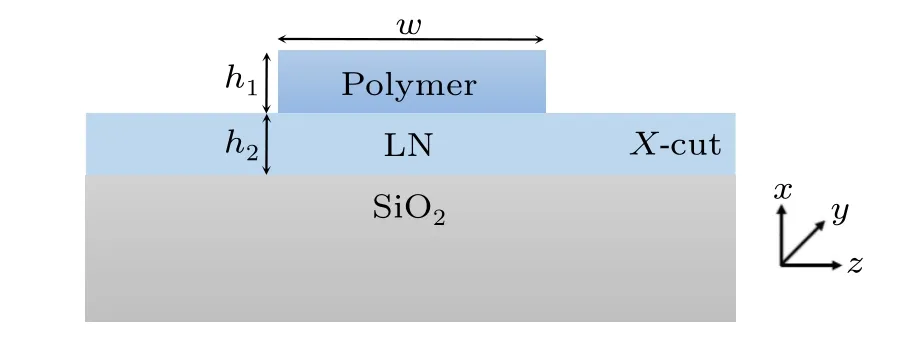
Fig.1. Schematic structure of the hybrid polymer-LN waveguide. The bottom is a thick layer of silica(gray),the middle is an X-cut LN thin film(light blue),and the top is a thin polymer waveguide(dark blue).
3. Simulation results and discussion
In order to implement phase-matching conditions 4–6 as listed in Table 1, one should carefully engineer the waveguide structural parameters so as to obtain bound modes for both pump and SHG wavelengths.[33]As indicated in our previous paper,[38]it is invalid to use conventional coupled mode theory since slowly varying envelope approximation is no more applicable for such hybrid waveguides. Instead, a finite-element method is adopted here in order to investigate the optical modes of hybrid coupled waveguides in a straightforward manner.[38]Refractive indices of lithium niobate were extracted from the open database, while the refractive index of the polymer was set as 2.15 so as to have considerable intra-coupling effects between polymer and LN thin film. And waveguide structure parameters were set asw=4 μm,h1=0.401 μm, andh2=0.4 μm, considering the facility of mature fabrication condition and acquiring the phase-matching condition. We firstly examine the possibility of phase matching between the TM01-like,TE00-like,and TE01-like modes at the pump wavelengthsλpranging from 800 nm to 1400 nm.According to the super-mode theory, TE00-like modes could be identified as fundamental even modes, while TM01-like and TE01-like modes could be identified as fundamental odd modes. As shown in Fig.2,the effective refractive indices of the mentioned modes (at SHG wavelengths for the TE01-like modes and at pump wavelengths for the TM01-like and TE00-like modes)were calculated as a function of wavelength.

Fig. 2. Simulated effective refractive indices of the mentioned modes (at SHG wavelengths for the TE01-like modes and at pump wavelengths for the TM01-like and TE00-like modes) as a function of wavelength. Effective refractive indices of the low-order waveguide modes at both pump wavelengths(TM01-like and TE00-like modes)and SHG wavelengths(TE01-like modes),and the inset(i)and inset(ii)show two enlarged phase-matching cases. The unit a.u. is short for arbitrary units.
Apparently,the intersecting points of the curves indicate phase matching of interacting modes. The inset (i) of Fig. 2 shows a detailed phase matching occurring between TM01-like mode at 911 nm and TE01-like mode at 455.5 nm. The modal profile of its largest electric field component (Ey) of TM01-like mode at 911 nm is plotted at the top of Fig. 3(a).It is easily seen that electric fieldEyis distributed in polymersection and LN-section with inversed polarity, which can be regarded as an odd mode according to super-mode theory.Meanwhile,the modal profile of its largest electric field component (Ez) of TE01-like mode at 455.5 nm is plotted at the bottom of Fig. 3(a). Similarly, TE01-like mode at 455.5 nm can be regarded as an odd mode. This case corresponds to phase-matching conditions 5 as listed in Table 1. Though theEycomponent of the TM01-like mode at 911 nm and theEzcomponent of the TE01-like mode at 455.5 nm are both with the inverse polarity between polymer area and LN area, the net modal overlap integral can be significant,due to the asymmetric profile ofχ(2)in the hybrid waveguide. The distribution curves of main electric field components alongxdirection are illustrated in Fig. 3(b), where dark blue area represents polymer waveguide and light blue area represents LN.And one may easily find that the spatial distributions of the two main electric fields are identical in the LN layer, which would lead to a considerably large modal overlap integral as predicted by the theory. From this point,phase-matching condition 5 is now achieved. The calculated modal overlap integralSis 0.365 and the effective modal areaAeffis 9.92 μm2.In this case,for a lossless waveguide without pumping depletion, the normalized conversion efficiencyηis estimated to be~9.11%W-1·cm-2,corresponding to a nonlinear conversion efficiency of 0.09% W-1for 1-mm-long waveguide. To be mentioned here,the nonlinearity coefficientd31,rather thand33,is used here because the main electric field component of the 911-nm TM01-like isEyinstead ofEz. However,it is difficult to utilize the largest nonlinearity coefficient during the nonlinear process due to the largest electric field component of TM01-like mode at 911 nm isEyinstead ofEz.
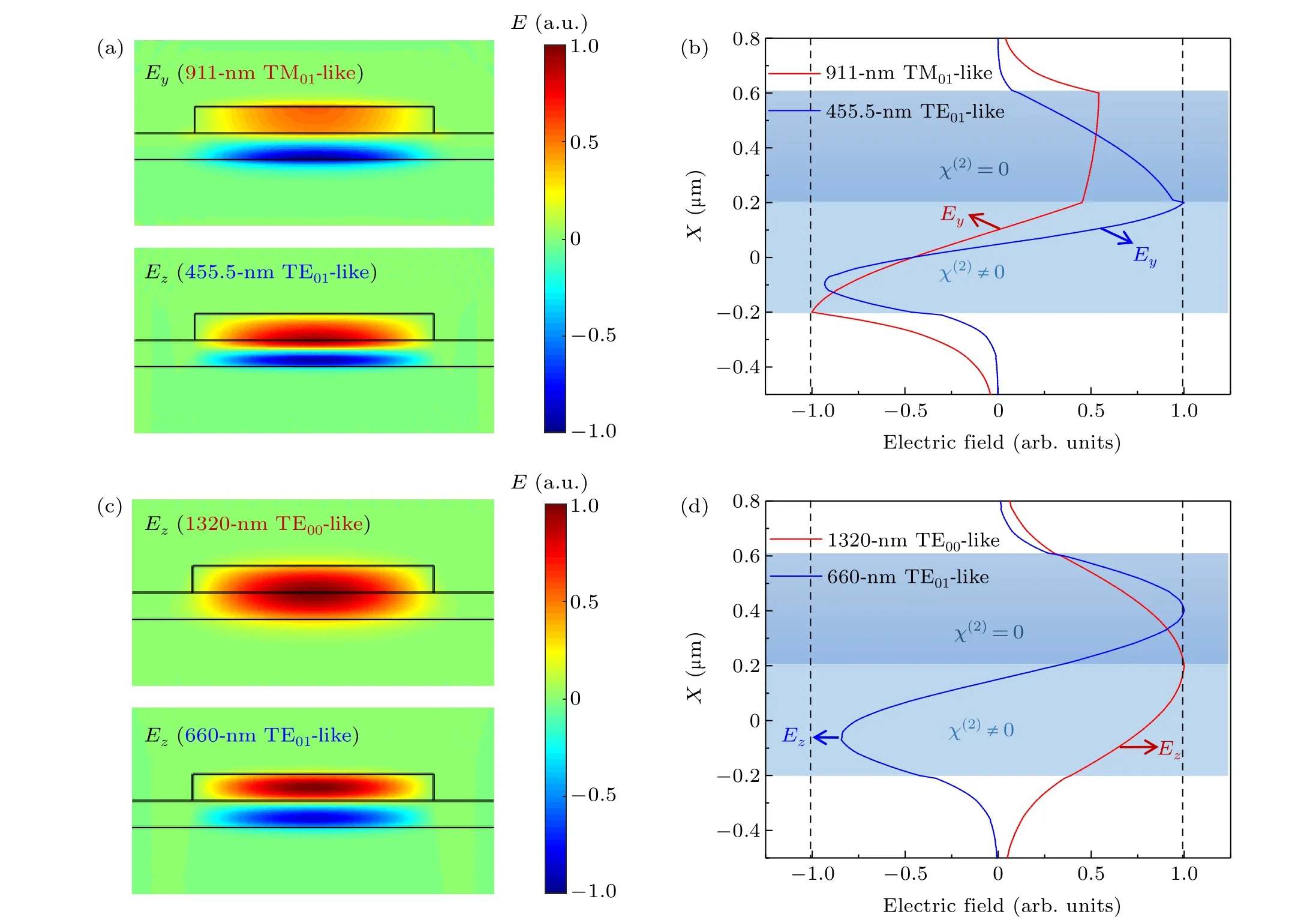
Fig.3. Simulated modal profiles: (a)the modal profiles of the largest electric field components of 911-nm TM01-like(top)and 455.5-nm TE01-like(bottom), and(b)the corresponding intensity distribution curves of the main electric field components along the x direction at both the pump(red line) and SHG (blue line) wavelengths. (c) The mode profiles of the largest electric field components of 1320-nm quasi-TE00 (top) and 660-nm quasi-TE01 (bottom),and(d)the corresponding intensity distribution curves of the main electric field components along the x direction at both the pump(red line)and SHG(blue line)wavelengths.
Another phase-matching point is found between TE00-like mode at 1320 nm and TE01-like mode at 660 nm,as shown in the inset (ii) of Fig. 2. The modal profile of its largest electric field component (Ez) of TE00-like mode at 1320 nm is plotted at the top of Fig.3(c). It is easily seen that the polarity of electric fieldEzis the same in both the polymer-section and LN-section,corresponding to an even mode according to super-mode theory.Meanwhile,the modal profile of its largest electric field component(Ez)of TE01-like mode at 660 nm is plotted at the bottom of Fig. 3(c). Similarly, TE01-like mode at 660 nm can be regarded as an odd mode. The distribution curves of main electric field components along the vertical direction (i.e., alongxaxis) of the waveguide are illustrated in Fig. 3(d). Again, the net modal overlap integral between the modes is calculated to be 0.299 with effective modal area of 8.77 μm2. To be pointed out, here the largest nonlinear coefficient,namelyd33is utilized,contributing to more efficient nonlinear optical conversion. Indeed, we obtain the normalized conversion efficiencyηas high as 148%W-1·cm-2,corresponding to a nonlinear conversion efficiency of 1.48%W-1for a 1-mm-long waveguide.This value is much higher(~300 times) than reported SHG efficiency in hybrid polymer-LN waveguide,[33]showing the advantage of our design presented in this paper. Recalling Eq.(1),it is reasonable for the larger conversion efficiency, since we have a largerχ(2)nonlinear coefficient (27 pm/Vversus-4.3 pm/V), larger modal overlap integralS(0.299versus0.14),and smaller effective modal areaAeff(8.77 μm2versus20.3 μm2).
Besides, we have fulfilled the phase-matching condition around 1550 nm by sweeping the height of hybrid waveguide.The phase-matching condition was realized between TM01-like mode at 1550 nm and TE01-like mode at 775 nm, withh1=425 nm,w=4 μm, andh2=0.4 μm. To be noted, the largest electric field component of TM01-like mode at 1550 nm isEy, and the largest electric field component of TE01-like mode at 775 nm isEz. Therefore, an effective nonlinear susceptibilityd31is utilized. And the corresponding modal overlap integralSis calculated to be 0.294 with effective modal area of 8.9 μm2. For a lossless waveguide without pumping depletion,the normalized conversion efficiencyηis estimated to be 2.75%W-1·cm-2.
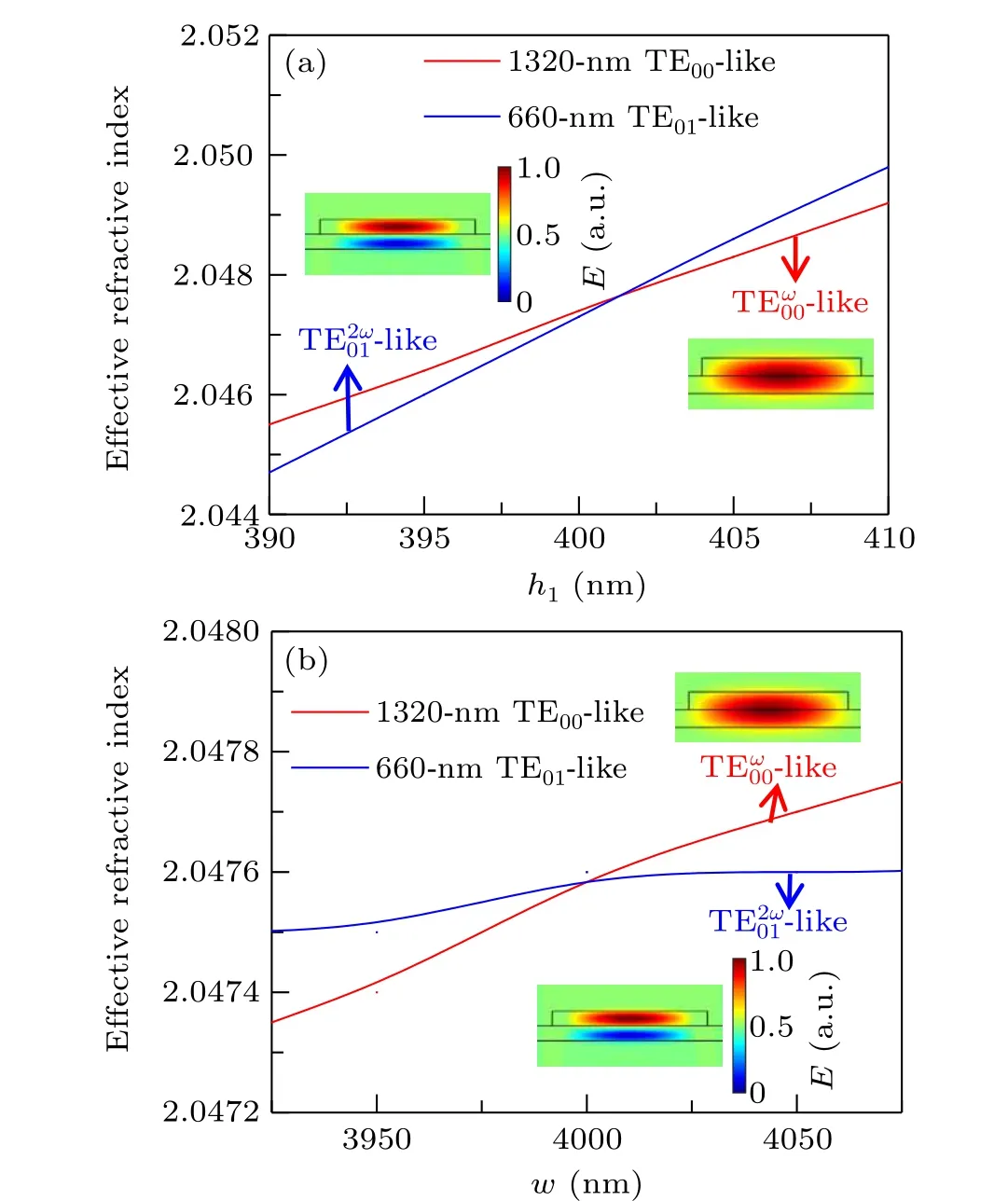
Fig. 4. The sensitivity of phase-matching condition 6 on geometric parameters. Effective refractive indices of the modes (inset (ii) of Fig. 2) at both wavelengths varying with(a)polymer waveguide height,h1 (with fixed w=4 μm and h2 =400 nm)and(b)width,w(with fixed h1 =401 nm and h2=400 nm).
We also investigated the structural sensitivity of above phase-matching condition on geometric parameters(i.e.,polymer waveguide heighth1and widthw) of the hybrid waveguide. For TE00-like mode at 1320 nm and TE01-like mode at 660 nm,dispersion relationships as functions of the waveguide heighth1and the waveguide widthware shown in Figs.4(a)and 4(b). As shown in Fig. 4(a), the effective modal refractive indices of TE00-like mode at 1320 nm increase by~0.001 when the waveguide heighth1changes from 400 nm to 405 nm. However,the effective modal refractive indices of TE00-like mode at 1320 nm increase only by~0.0001 when the waveguide widthwchanges from 4000 nm to 4050 nm,as shown in Fig. 4(b). Apparently, the modal refractive indices vary more slowly with the change of waveguide width. This is benefited from the larger waveguide dimension inzdirection (~4 μm) thanxdirection (~0.4 μm). Therefore, it indicates that one is more convenient to engineer the width than the height of the polymer waveguide for detuning the phasematching condition. And the relatively large value (micrometer scale)of polymer waveguide width significantly releases the difficulty of polymer fabrication. The proposed waveguide holds the fabrication feasibility and is promising for future onchip efficient nonlinear conversion devices.
4. Conclusion
In conclusion, we have presented a simple hybrid polymer-LN semi-nonlinear waveguide to realize efficient onchip SHG by directly constructing polymer waveguide on theX-cut LNOI.Both symmetric(even)and antisymmetric(odd)modes of the pump and SHG waves in the hybrid waveguide were employed to achieve phase matching with large modal overlap. The largest nonlinear coefficient, namelyd33, could be utilized for phase matching between a fundamental even(TE00-like) mode at 1320 nm and a fundamental odd (TE01-like)mode at 660 nm,with an efficient calculated normalized conversion efficiency of 148% W-1·cm-2. Considering the fabrication feasibility of such a hybrid waveguide with features including etchless, large dimension, and low structural sensitivity, we believe our findings would provide a useful reference for future on-chip efficient nonlinear conversion devices.
Acknowledgments
Project supported by the National Natural Science Foundation of China (Grant Nos. 91850107 and 12174116),the National Key Research and Development Program of China (Grant No. 2018YFA0306200), Guangdong Innovative and Entrepreneurial Research Team Program (Grant No. 2016ZT06C594), the Key Program of Guangzhou Scientific Research Special Project (Grant No. 201904020013),the Science and Technology Project of Guangdong Province,China (Grant No. 2020B010190001), and the Fundamental Research Funds for the Central Universities.
- Chinese Physics B的其它文章
- Formation of high-density cold molecules via electromagnetic trap
- Dynamics of molecular alignment steered by a few-cycle terahertz laser pulse
- Terahertz spectroscopy and lattice vibrational analysis of pararealgar and orpiment
- Molecule opacity study on low-lying states of CS
- Finite-time Mittag–Leffler synchronization of fractional-order complex-valued memristive neural networks with time delay
- Ultrafast Coulomb explosion imaging of molecules and molecular clusters

